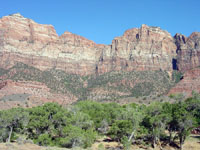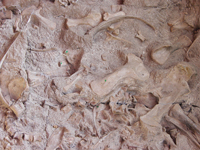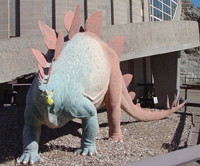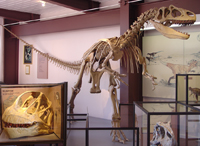Jurassic Period (201 to 145 million years)
The cause of the mass extinction at the end of Triassic is still unclear, but evidence shows that it was associated with rapid and massive amounts of volcanism that was taking place with the breakup of Pangaea (created by the opening of the Atlantic Ocean basin as North and South America gradually split away from the African and European continents).
With other life forms out of the way, dinosaurs adapted and diversified into a wide variety of groups. Although pterosaurs were the dominant flying vertebrates during the Jurassic Periods, the first birds appeared—having evolved from a branch of theropod dinosaurs. Rare small mammals occur in the fossil record during the Jurassic Period, but remained insignificant compared to the dinosaurs that dominated the landscape. Large marine reptiles including ichthyosaurs and plesiosaurs dominated the oceans.
 |
Sedimentary rocks of the Zuni Sequence are well preserved and throughout the Colorado Plateau region. During the late Jurassic Period a great coastal sand desert covered much of the western part of the continental United States. This ancient sand desert would rival the large deserts of the Sahara or Arabian Peninsula that exist today. Through time, the desert conditions gave way to more humid coastal conditions with river systems and coastal swamplands (home to a variety of dinosaurs of the Jurassic and following Cretaceous Periods). The massive white cliffs of Zion National Park preserve evidence of this great sand desert in the western United States (Figure 15.48). |
| Figure 2.48. Massive sandstone cliffs of the Navajo Sandstone of Jurassic age are well exposed in Zion National Park, Utah |
 |
 |
 |
 |
Figure 2.46. Dinosaur tracks
in Jurassic-age rocks near Tuba City, Arizona. |
Figure 2.47. Dinosaur bones preserved in ancient river bed sediments, Dinosaur National Monument, Utah. |
Figure 2.49. Reconstruction of Stegasaurus, a Jurassic-age vegetarian dinosaur with unusual spinal plates. Dinosaur National Monument, Utah. |
Figure 2.50. Skeleton of Allosaurus, a massive carnivorous dinosaur from the Jurassic Period. Dinosaur National Monument, Utah. |







